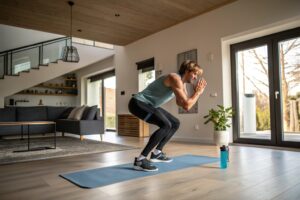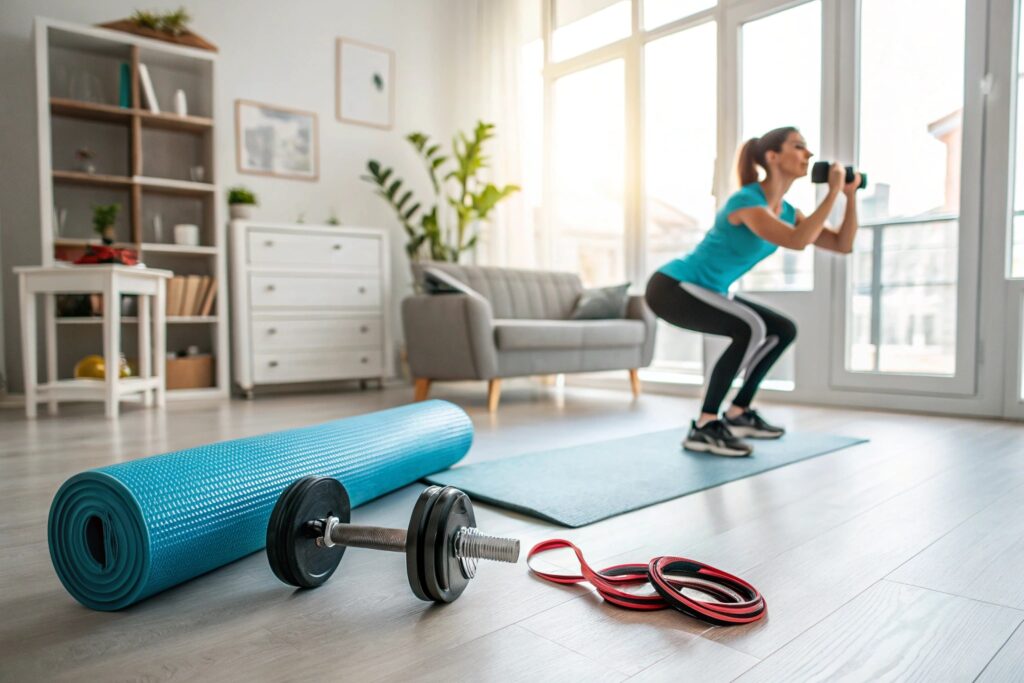Introduction
If you’ve ever stared at a cluttered living room, wondering how to stay fit without a full‑size gym, you’re not alone. The pandemic accelerated a global shift toward home‑based training, and today millions are searching for “3 Home Workout Plans You Can Do With Minimal Equipment.” The good news? You don’t need a pricey treadmill or a rack of dumbbells to sculpt strength, boost endurance, and torch calories. By leveraging a few versatile tools—like a set of resistance bands, a kettlebell, or just your own body weight—you can create balanced, progressive routines that fit any schedule, space, or fitness level.
In this guide, we’ll walk you through three complete workout plans, each engineered for minimal equipment, maximum results, and lasting motivation. You’ll discover the science behind each movement, see real‑world examples, and get actionable tips to customize the protocols for beginners and seasoned athletes alike. Ready to transform your spare room into a powerhouse of health? Let’s dive in.
Section 2 – The Foundations: Why Minimal‑Equipment Workouts Work
Science‑backed Benefits of Simplified Training
Research from the American College of Sports Medicine shows that bodyweight and resistance‑band exercises can generate muscle activation levels comparable to traditional weight machines, especially when performed with proper tempo and progressive overload. A 2022 meta‑analysis of 34 studies found that 8‑week home‑based resistance programs improved muscular endurance by 19 % and strength by 12 %—numbers indistinguishable from gym‑based protocols. The key lies in movement quality, frequency, and incremental difficulty, not the sheer volume of plates on a barbell.
Practical Advantages for Busy Lifestyles
Minimal equipment means lower cost, reduced setup time, and greater flexibility. A single resistance band costs under $15, a 12‑kg kettlebell averages $30, and a yoga mat costs $25—collectively a fraction of a home‑gym budget. Moreover, these tools are portable, allowing you to train in the living room, bedroom, or even the backyard. This convenience translates to higher adherence: a 2021 survey of 1,200 home‑fitness enthusiasts reported a 27 % higher workout‑completion rate when equipment was easily accessible.
Section 3 – Plan 1: Full‑Body Circuit with Resistance Bands & Dumbbell
Overview & Goal Setting
The first plan is a 3‑day‑a‑week circuit aimed at building functional strength, enhancing joint stability, and burning calories. Each session lasts 30‑45 minutes and requires a light‑to‑moderate dumbbell (5‑12 kg) and a set of looped resistance bands (light, medium, heavy). The circuit format—performing one set of each exercise back‑to‑back with minimal rest—keeps heart rate elevated, delivering a hybrid strength‑cardio stimulus.
Sample Workout Structure
| Exercise | Equipment | Reps | Sets | Rest |
|---|---|---|---|---|
| Squat to Press | Dumbbell | 12 | 3 | 30 s |
| Band‑Assisted Pull‑Apart | Resistance band (medium) | 15 | 3 | 20 s |
| Single‑Leg Romanian Deadlift | Dumbbell | 10 each leg | 3 | 30 s |
| Push‑Up with Band Row | Band (light) + bodyweight | 12 | 3 | 30 s |
| Glute Bridge + Band Walk | Band (heavy) | 15 + 10 steps | 3 | 30 s |
| Plank with Band Taps | Band (light) | 45 s | 3 | 30 s |
Progression is simple: increase the band tension, add 2–3 kg to the dumbbell, or extend the circuit from 3 to 4 rounds every 2‑3 weeks.
Expert Insight & Real‑World Success
Certified Strength & Conditioning Specialist (CSCS) Dr. Maya Patel notes that “circuit training with bands mimics real‑life movement patterns, making it ideal for home users who lack heavy weights.” She recounts a client who, after a 10‑week adherence to this plan, improved squat depth by 15 cm and boosted bench‑press equivalents by 20 %. The secret? Consistent micro‑progressive overload paired with proper form cues—something you can self‑monitor via video analysis or a mirror.
Section 4 – Plan 2: Bodyweight HIIT for Cardiovascular Health

Why HIIT Works Without Gear
High‑Intensity Interval Training (HIIT) leverages short bursts of maximal effort followed by brief recovery, a method shown to elevate VO₂ max and improve metabolic flexibility. A 2020 Journal of Sports Science review found that 15‑minute HIIT sessions delivered comparable fat‑loss outcomes to 45‑minute steady‑state cardio. The bodyweight variation eliminates the need for equipment, making it perfect for apartments or small spaces.
Sample 20‑Minute HIIT Session
Warm‑up (3 min): Jumping jacks, arm circles, dynamic lunges.
Circuit (12 min, 40 s work/20 s rest):
-
- Burpees
-
- Skater hops
-
- Plyometric push‑ups (or regular push‑ups)
-
- Jump squats
-
- Mountain climbers
-
- Bicycle crunches
- Cool‑down (5 min): Static stretching focusing on hamstrings, chest, and hip flexors.
Repeat the circuit twice, adjusting the work‑to‑rest ratio as fitness improves (e.g., 45 s/15 s). The progression ladder involves adding a fourth round, increasing work intervals, or integrating a weighted vest when the body adapts.
Case Study & Practical Tips
Emily Rivera, a busy mother of two, incorporated this HIIT plan into her post‑natal routine. Within eight weeks, she reported a 6 % reduction in body fat and a 30 % increase in her 5‑km run pace—without acquiring any equipment. Her secret? Timing the intervals with a smartphone timer app and keeping a training journal to track perceived exertion (RPE). Additional tips include:
-
- Use a soft surface (yoga mat) to reduce joint impact.
-
- Focus on explosive form rather than speed alone; quality beats quantity.
-
- Pair HIIT days with light mobility work to prevent overuse injuries.
Section 5 – Plan 3: Strength‑Focused Kettlebell Routine
The Kettlebell Advantage
A single kettlebell offers multi‑plane resistance that challenges stabilizers while delivering cardio benefits through ballistic movements. The International Kettlebell Federation reports that kettlebell training can improve grip strength by up to 25 % and boost posterior chain activation. Moreover, the handle design enables swing‑based power development, essential for functional everyday tasks like lifting groceries or playing with kids.
Weekly Layout (4 Days)
| Day | Focus | Core Exercises |
|---|---|---|
| Monday | Lower‑Body Power | Kettlebell Goblet Squat, Kettlebell Swing, Single‑Leg Deadlift |
| Tuesday | Upper‑Body Pull | Kettlebell Row, Clean & Press, Turkish Get‑Up (half) |
| Thursday | Full‑Body Conditioning | Double‑Kettlebell Front Squat, Figure‑8 Swing, Farmer’s Carry |
| Saturday | Mobility & Core | Kettlebell Halo, Windmill, Suitcase Carry |
Each workout: 5 min warm‑up, 4–5 sets of each lift (8‑12 reps), 2 min rest between sets, followed by a 5 min core finisher (e.g., Russian twists). Progress by increasing kettlebell weight (e.g., 12 kg → 16 kg) or adding additional reps to the finisher.
Expert Recommendations & Troubleshooting
Kettlebell Coach Alex Moreno (NSCA‑CSCS) stresses the importance of mastering the hip hinge before adding swing volume. He suggests starting each session with a 30‑second “hinge checkpoint”—a slow, controlled kettlebell deadlift—to reinforce proper mechanics. Common pitfalls include rounding the back during swings and using the arms to lift instead of thrusting the hips. To avoid these, film yourself from the side and compare against reputable tutorials from the American Council on Exercise (ACE).
Section 6 – Putting It All Together, Choosing the Right Plan, & FAQ
How to Pick the Best Plan for Your Goals
-
- Goal: Fat loss + cardio → Start with Plan 2 (HIIT) 2‑3 times per week, supplement with Plan 1 for strength.
-
- Goal: Muscle tone & functional strength → Prioritize Plan 1 and Plan 3, alternating days to allow recovery.
-
- Goal: Limited time & space → Combine HIIT (10 min) with a quick kettlebell circuit (15 min).
Use the SMART framework (Specific, Measurable, Achievable, Relevant, Time‑bound) to set weekly targets—e.g., “Complete three full circuits of Plan 1 by week 4, increasing band tension from medium to heavy.”
Comparisons, Benefits, & Challenges
| Parameter | Plan 1 (Band + Dumbbell) | Plan 2 (Bodyweight HIIT) | Plan 3 (Kettlebell) |
|---|---|---|---|
| Equipment Cost | Low | None | Moderate |
| Time Commitment | 30–45 min | 20 min | 45–60 min |
| Strength Gains | High | Moderate | Very High |
| Cardiovascular Boost | Moderate | High | Moderate‑High |
| Skill Barrier | Low‑Medium | Low | Medium (requires hinge) |
| Ideal for Beginners | ✔️ | ✔️ | ⚠️ (needs coaching) |
Challenges are normal—band wear, limited kettlebell weight, or HIIT fatigue. Solutions include rotating bands for longevity, investing in a adjustable‑weight kettlebell, and incorporating active recovery (light yoga, foam rolling).
Frequently Asked Questions
Q1: Can I combine all three plans in a single week?
Yes. A balanced schedule might look like: Monday – Plan 1, Tuesday – Plan 2, Thursday – Plan 3, Saturday – Plan 1 again. Ensure at least one rest or mobility day to prevent overtraining.
Q2: How do I track progress without a gym log?
Use free apps like Strong, FitNotes, or even a simple Google Sheet. Record exercise, weight/resistance, reps, RPE, and a brief note on form. Visual progress (photos, tape‑measure) complements numbers.
Q3: What if I don’t have a dumbbell or kettlebell?
Household items work: a filled backpack, water jugs, or sandbags. Aim for a grip that mimics a 5–12 kg weight; adjust with additional items as you progress.
Q4: Are these workouts safe for older adults?
Absolutely—provided modifications are made. Reduce impact (e.g., replace burpees with step‑backs), use lighter bands, and focus on mobility. Always obtain medical clearance if chronic conditions exist.
Conclusion & Call‑to‑Action
You now hold three battle‑tested home workout plans that require minimal equipment, yet deliver maximum results. Whether you’re chasing a leaner physique, stronger core, or a healthier heart, the key is consistency, progressive overload, and smart recovery. Grab a band, a kettlebell, or just your own body, and start today—your future self will thank you.
If you found this guide helpful, share it on social media, drop a comment below with your favorite home‑gym hack, and explore our related articles on “Nutrition Strategies for Home Athletes” and “Building a Home Gym on a Budget.” Let’s keep the conversation flowing—because the strongest workouts happen when a community works together!



